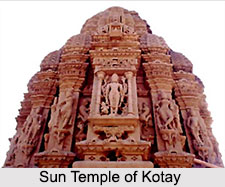 The village of Kotay is located on the Bhuj Taluka of the Kutch district in Gujarat. It is located 24 km towards north from the district headquarters of Bhuj and is 343 km from the state capital, Gandhinagar. The local language here spoken by the natives is Gujarati. Ahirs, Rabaris and Harijans are the main residents of Kotay.
The village of Kotay is located on the Bhuj Taluka of the Kutch district in Gujarat. It is located 24 km towards north from the district headquarters of Bhuj and is 343 km from the state capital, Gandhinagar. The local language here spoken by the natives is Gujarati. Ahirs, Rabaris and Harijans are the main residents of Kotay.
Demographics of Kotay Village
As per the reports of Census India 2011, the village of Kotay has a total of 219 families residing. The total population of the village is 1005 out of which 505 are males while 500 are females. The population of children between the ages 0 to 6 years makes up 15.82 percent of the total population. The average sex ration of Kotay village is 990, which is higher than the state average of 919. While, the child sex ratio for the village is 871, which is lower than the state average of 890. The literacy rate of Kotay village is 62.41 percent, lower than the Gujarat average of 78.03 percent. Here, in the village, the male literacy stands at 77.38 percent and the female literacy at 47.65 percent. The count of working individual of Kotay village is 373 yet 632 are un-employed. And out of 373 working people 154 peoples are completely reliant on agriculture.
Places of Interest of Kotay Village
The Sun or the Shiva Temple of the Kotay village used to be an architectural beauty whose ruins now stand as a testament of its past grandeur. Also known as Ra Lakha"s, the temple was ascribed to Lakha Phulani, who was the grandson of the King of Sindh, Jam Lakho Dhuraro. The Sun Temple is known to be built in the 9th century and the style of the construction of the temple is reminiscent of the Khajuraho Art. The aisles of the temple are similar to some of the aisles of the Chaitya caves and the central area is covered with huge slabs hollowed out in the centre. The door of the temple is neatly carved. Over the lintel are the nine patrons of the planets and the jambs are carefully sculptured. In the entrance hall the mandaps have 4 pillars with a square block sculptured below the bracket and has six pilasters. The pillars and pilasters are all of the Hindu broken-square form. To the west of the Sun Temple, there are 3 other smaller temples. Facing the north side is a tiny Vaishnav temple, with only a fragment of the shrine remaining. On the east-facing temples, there is only a shrine left and the walls are carved with figures of Surya on the west, shradulas in the recesses, a figure of Lord Ganpati on the lintel and the figure of Varaha which has fallen off the south wall. Outside the north wall is Narsimha and on the west is Lord Vishnu, both of which has been worn down with time. Across a ravine to the north-east are fragments of two other temples facing west.
Visiting Information on Kotay Village
The village of Kotay has a railway station not less than 10 km away, which is connected via trains to the Rajkot Junction Railway Station, which is at a distance of 179 km away from Kotay.



















